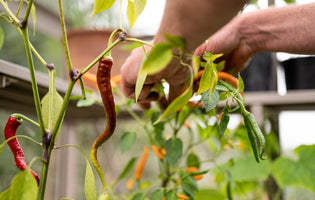In the quest to create harmonious living spaces, incorporating houseplants has become a rejuvenating interior design trend. Each room presents a unique canvas for the greenery to thrive and contribute to the overall ambiance.
From the vibrant living room adorned with lush ferns, dramatic Monsteras, and elegant Peace Lilies, to the tranquil bedroom oasis featuring the calming fragrance of lavender, cascading Pothos vines, and versatile English Ivy. The functional yet aesthetic kitchen with the Peperomia's unique charm, versatile herbs like Mint and Parsley, and the distinctive Ponytail Palm —each space is carefully curated. Even the bathroom becomes a lush retreat with the soothing Aloe Vera, delicate Boston Fern, and elegant Spider Plant.
Additionally, we'll explore essential care tips on how to look after your plants including how often you should water house plants, and what are the best house plants for each room ensuring your indoor green companions flourish in every room.
Join the team at Rhino Greenhouses Direct on a journey through various rooms, discovering the perfect plant companions that not only enhance aesthetics but also promote a healthier and more harmonious living environment. Stepping into the heart of the home, let's explore the living room, a vibrant space adorned with lush ferns, dramatic Monsteras, and elegant Peace Lilies.
Plants for the Living Room
Enhance the ambiance of your living room with vibrant greenery. From the lush and feathery ferns to the dramatic leaves of Monsteras and the elegant blooms of Peace Lilies, each plant not only adds aesthetic appeal but also contributes to a healthier indoor environment.
Ferns
Appearance: Ferns add a lush and feathery green texture to the living room, creating a calming and natural atmosphere.
Air Purification: Ferns release moisture through a process called transpiration, which can contribute to increased humidity levels in the living room, benefiting both the plants and occupants.
How to Care: Many fern varieties can thrive in indirect light, making them suitable for living rooms with varying light conditions. They also require consistently moist soil. Regular misting can help maintain humidity.
Monsteras
Appearance: Monsteras are known for their large, dramatic leaves, making them a striking focal point in the living room, and contributing to a trendy and modern aesthetic.
Air Purification: Monsteras are effective air purifiers, helping to remove common indoor pollutants and improving overall air quality.
How to Care: Monsteras are relatively low-maintenance and can tolerate a range of light conditions, making them versatile and easy to care for. Regular watering and well-draining soil are essential.
Peace Lily
Appearance: Peace lilies have elegant, dark green leaves and white blooms, adding a touch of sophistication to the living room decor.
Air Purification: Peace lilies are excellent air purifiers, removing toxins like formaldehyde, benzene, and ammonia from the air.
How to Care: Peace lilies can thrive in low to moderate light conditions, making them suitable for living rooms with less natural sunlight. Keep the soil consistently moist and provide occasional indirect sunlight.
Plants for the Bedroom(s)
Moving from the lively living room, we enter the tranquil haven of the bedroom(s), where the soothing fragrance of lavender, cascading Pothos vines, and versatile English Ivy create a serene and healthier sleeping environment.
Lavender
Appearance: Lavender features slender green stems with fragrant, linear leaves. Its distinctive purple blooms add color and elegance to the bedroom.
Air Purification: While not a strong air purifier, lavender is known for its calming fragrance, promoting a serene atmosphere in the bedroom.
How to care: Lavender prefers bright light and well-draining soil. It requires occasional sunlight and can be grown in pots or containers.
Pothos
Appearance: Pothos features heart-shaped leaves that vary in color, including green, variegated, and golden hues. Its trailing vines add a cascading and decorative element to the bedroom.
Air Purification: Recognized for efficient air purification, Pothos removes pollutants, promoting a healthier bedroom environment.
How to care: Low-maintenance and adaptable, Pothos thrives in indirect light, tolerates low light, and benefits from well-draining soil. Regular pruning encourages optimal growth.
English Ivy
Appearance: English Ivy has cascading vines with lobed leaves. Its versatile growth can be adapted to hanging baskets, shelves, or as a trailing plant in the bedroom.
Air Purification: English Ivy is known for its air-purifying qualities, removing common indoor pollutants, and contributing to a healthier bedroom environment.
How to care: English Ivy prefers bright, indirect light but can tolerate lower light conditions. Regular pruning helps maintain its appearance, and it adapts well to indoor conditions.
Plants for the Kitchen
Now, let's venture into the kitchen, a culinary haven that comes to life with the visually appealing Peperomia, versatile herbs like Mint and Parsley, and the distinctive presence of the Ponytail Palm. These plants not only add freshness to your kitchen but also contribute to a healthier and aesthetically pleasing cooking space.
Peperomia Plant
Appearance: Peperomia plants feature thick, fleshy leaves in various shapes and vibrant colors, with a glossy texture, offering a visually appealing and diverse aesthetic.
Air Purification: While not as efficient as some air-purifying plants, Peperomias contribute to indoor air quality by absorbing and processing airborne toxins through their leaves, promoting a healthier living space.
How to care: Provide bright, indirect light, maintain even soil moisture, and keep temperatures between 18-24°C. Their low maintenance, compact size, and suitability for smaller spaces make them ideal for kitchens, adding both aesthetics and practicality.
Herbs [Parsley & Mint]
Appearance: Herbs like mint and parsley exhibit distinct appearances. Mint has serrated leaves with a vibrant green color and a refreshing aroma, while parsley features lush, deeply divided leaves, contributing both flavor and visual appeal.
Culinary Benefits: Mint and parsley serve as versatile culinary herbs. Mint adds a cool, refreshing flavor to dishes and beverages, while parsley offers a fresh, mildly peppery taste, enhancing a wide range of recipes.
How to care: Both mint and parsley thrive in well-draining soil with regular watering. Place them in areas with partial sunlight, and trim regularly to encourage growth. Their adaptability and ease of cultivation make them suitable for kitchen gardens or indoor pots.
Ponytail Palm Plant
Appearance: The Ponytail Palm is characterized by a striking, bulbous trunk that tapers into long, arching, strap-like leaves resembling a ponytail. Its unique, visually appealing form makes it a distinctive addition to indoor spaces.
Air Purification: Beyond its distinctive appearance, the Ponytail Palm contributes to air purification, enhancing indoor air quality as it thrives on neglect.
How to care: Thriving on minimal care, this plant requires infrequent watering, well-draining soil, and bright, indirect light, making it an attractive and hassle-free choice for indoor plant enthusiasts.
Plants for the Bathroom
Finally, we turn our attention to the bathroom, transforming this functional space into a lush retreat with the soothing Aloe Vera, delicate Boston Fern, and elegant Spider Plant. These green companions thrive in bathroom conditions while providing functional and aesthetic benefits.
Aloe Vera
Appearance: Aloe Vera is recognized by its fleshy, pointed leaves arranged in a rosette, presenting a distinctive and visually soothing appearance suitable for bathroom environments.
Air Purification: In addition to its aesthetic appeal, Aloe Vera contributes to air purification, absorbing pollutants commonly found in bathroom spaces, fostering a cleaner and more refreshing atmosphere.
How to care: Aloe Vera's low-maintenance nature aligns with bathroom conditions, thriving in lower light levels and humid environments. Its gel-filled leaves offer a natural remedy for minor burns or skin irritations, making it a functional and health-promoting choice for bathroom settings.
Boston Fern
Appearance: The Boston Fern is characterized by delicate, feathery fronds that arch gracefully, presenting a lush and vibrant green presence ideal for bathroom aesthetics.
Air Purification: Beyond its visual charm, the Boston Fern excels in air purification, effectively removing common indoor pollutants, promoting cleaner and healthier air in bathroom spaces.
How to care: Well-suited for bathroom conditions, the Boston Fern thrives in high humidity and lower light levels. Keep the soil consistently moist, mist the foliage for high humidity, maintain temperatures between 15-24°C, use well-draining acidic soil, fertilize every 4-6 weeks during the growing season, prune regularly, and repot every 1-2 years for optimal health and lush, vibrant fronds.
Spider Plant
Appearance: Spider plants feature arching, cascading leaves with green and white stripes, creating an elegant and visually appealing aesthetic that brings a touch of freshness to bathroom spaces.
Air Purification: In addition to their aesthetic appeal, Spider Plants excel in air purification, efficiently removing common indoor pollutants. Their presence in bathrooms contributes to a cleaner and healthier air environment.
How to care: Well-suited for bathroom conditions, Spider Plants thrive in indirect light and tolerate the lower temperatures often found in these spaces. Water when the top inch of soil is dry, maintain temperatures between 12-25°C, use well-draining soil, feed with diluted fertilizer bi-monthly during the growing season, prune brown or yellow leaves, and repot if crowded, ensuring a thriving and resilient indoor green companion.
In the pursuit of harmonious living, houseplants have become a rejuvenating interior design trend. Each room serves as a unique canvas for greenery, enhancing ambiance and promoting a healthier indoor environment. So, with everything you need in one guide why not head to your local garden center and start bringing the nature indoors!








